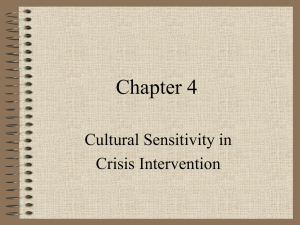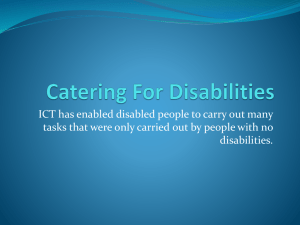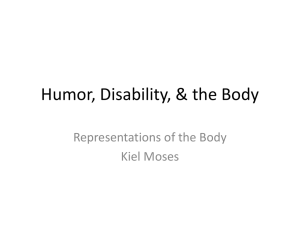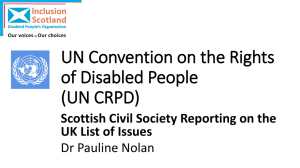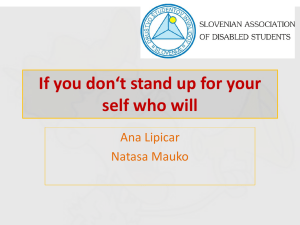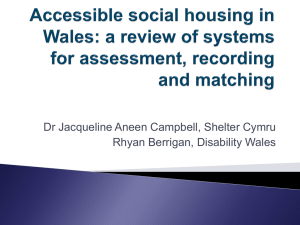- World of Inclusion
advertisement
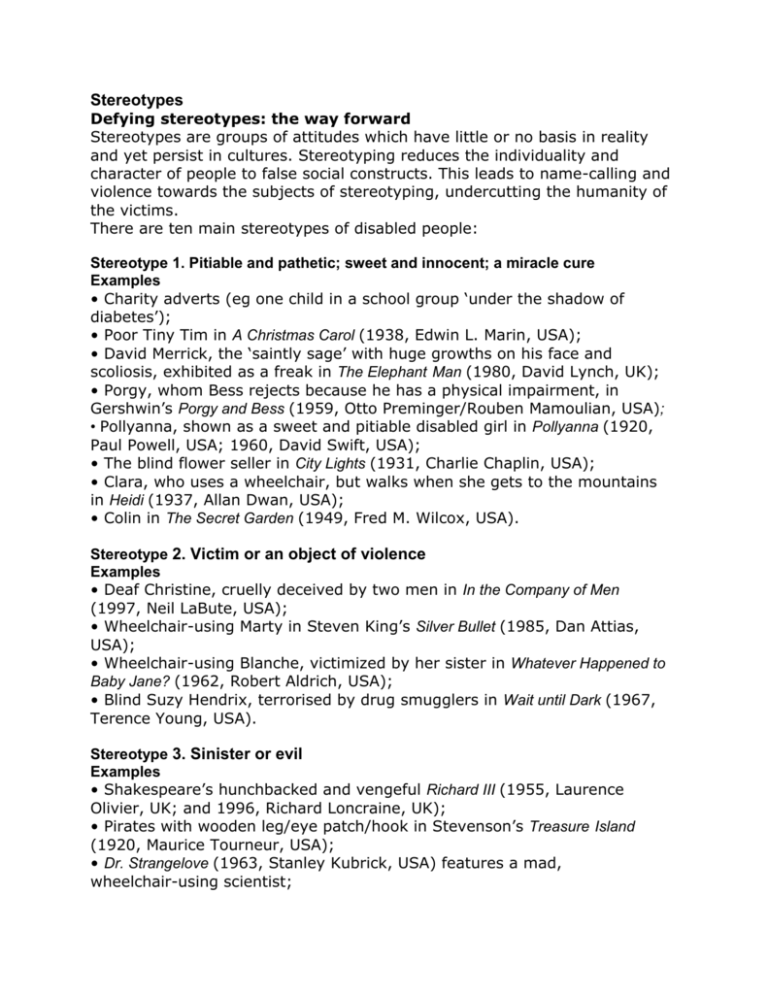
Stereotypes Defying stereotypes: the way forward Stereotypes are groups of attitudes which have little or no basis in reality and yet persist in cultures. Stereotyping reduces the individuality and character of people to false social constructs. This leads to name-calling and violence towards the subjects of stereotyping, undercutting the humanity of the victims. There are ten main stereotypes of disabled people: Stereotype 1. Pitiable and pathetic; sweet and innocent; a miracle cure Examples • Charity adverts (eg one child in a school group ‘under the shadow of diabetes’); • Poor Tiny Tim in A Christmas Carol (1938, Edwin L. Marin, USA); • David Merrick, the ‘saintly sage’ with huge growths on his face and scoliosis, exhibited as a freak in The Elephant Man (1980, David Lynch, UK); • Porgy, whom Bess rejects because he has a physical impairment, in Gershwin’s Porgy and Bess (1959, Otto Preminger/Rouben Mamoulian, USA); • Pollyanna, shown as a sweet and pitiable disabled girl in Pollyanna (1920, Paul Powell, USA; 1960, David Swift, USA); • The blind flower seller in City Lights (1931, Charlie Chaplin, USA); • Clara, who uses a wheelchair, but walks when she gets to the mountains in Heidi (1937, Allan Dwan, USA); • Colin in The Secret Garden (1949, Fred M. Wilcox, USA). Stereotype 2. Victim or an object of violence Examples • Deaf Christine, cruelly deceived by two men in In the Company of Men (1997, Neil LaBute, USA); • Wheelchair-using Marty in Steven King’s Silver Bullet (1985, Dan Attias, USA); • Wheelchair-using Blanche, victimized by her sister in Whatever Happened to Baby Jane? (1962, Robert Aldrich, USA); • Blind Suzy Hendrix, terrorised by drug smugglers in Wait until Dark (1967, Terence Young, USA). Stereotype 3. Sinister or evil Examples • Shakespeare’s hunchbacked and vengeful Richard III (1955, Laurence Olivier, UK; and 1996, Richard Loncraine, UK); • Pirates with wooden leg/eye patch/hook in Stevenson’s Treasure Island (1920, Maurice Tourneur, USA); • Dr. Strangelove (1963, Stanley Kubrick, USA) features a mad, wheelchair-using scientist; • Evil Dr. No, with his two false hands in the Bond film, Dr. No (1962, Terence Young, UK); • The pirate captain in Hook (1991, Steven Spielberg, USA); • Terrifying Freddy in Nightmare on Elm Street (1984, Wes Craven, USA); • Bitter and vengeful Mr Glass with his brittle bones in Unbreakable (2000, M. Night Shyamalan, USA). Stereotype 4. Atmosphere – curios or exotica in ‘freak shows’, and in comics, horror movies and science fiction Examples • A whole cast of genuinely disabled people was used to create horror in Freaks (1932, Tod Browning, USA); • The facially disfigured Phantom, in Phantom of the Opera (1925, Rupert Julian, USA); • The deaf, dumb and blind kid in Tommy (1975, Ken Russell, UK); • All the ‘baddies’ who have tics and disabilities in Dick Tracy (1990, Warren Beatty, USA); • Cousin Lyman, a short hunchback who causes trouble in The Ballad of the Sad Café (1991, Simon Callow, UK/USA); • The one-armed man in The Fugitive (1993, Andrew Davis, USA). Mini Me in the Spy who loved Me Stereotype 5. ‘Super-crip’/ triumph over tragedy/noble warrior Examples • A spinally-injured veteran coming to terms with his impairment in The Men (1950, Fred Zinnemann, USA); • Physically-impaired Douglas Bader walking without sticks and flying in Reach for the Sky (1956, Lewis Gilbert, UK); • A war veteran coping with his injuries again in The Best Years of Our Lives (1946, William Wyler, USA); • Christy Brown writing in My Left Foot (1989, Jim Sheridan, UK); • Blind Mathew Murdock has radar-like senses he uses to fight evil in Daredevil (2003, Mark Steven Johnson, USA); • The last item on the TV news, eg a blind man climbing a mountain. Stereotype 6. Laughable or the butt of jokes Examples • In many early films, such as The Automobile Accident (1904) or the over 100 films featuring ‘Crettini’; • All the men who are short people in Time Bandits (1981, Terry Gilliam, UK); • Dumb and Dumber, featuring two men with learning difficulties in laughable situations (1988, Charles Crichton, USA); • The lead character is a man with learning difficulties in Forrest Gump (1994, Robert Zemeckis, USA); • Lee Evans feigning cerebral palsy in There’s Something About Mary (1998, Peter Farrelly/Bobby Farrelly, USA); Mr. Magoo, the shortsighted butt of jokes in cartoons and film (2001, Walt Disney, USA). The Idiots Lars Von Trier Stereotype7. Having a chip on their shoulder/ aggressive avenger Examples • The Claw, who is twisted and evil, inDick Tracy (1947, John Rawlins, USA) because he has lost a hand; • Captain Ahab in Moby Dick (1956, John Huston, USA); • Laura in The Glass Menagerie (1987, Paul Newman, USA); • Captain Hook, the wicked pirate in Hook; • The vengeful, hook-using, black ghost in Candyman (1992, Bernard Rose, USA). Stereotype 8. A burden/outcast Examples • The disabled wife who feels she is a useless burden in Ich Klage An (I Accuse) (1941, Wolfgang Liebeneiner); The disabled child whose parents consider euthanasia in A Day in the Death of Joe Egg (1971, Peter Medak, UK); • The facially disfigured boy in Mask (1985, Peter Bogdanovich, USA); • The ‘In-valids’ who are not of perfect genetic design in Gattaca (1997, Andrew Niccol, USA), • The TV series Beauty and the Beast, set in subterranean New York, the Morlocks in the X-Men comics or X2, (2003, Bryan Singer, USA), in which characters with impairments live apart from society; • Despised outcast, Quasimodo, in The Hunchback of Notre Dame (1923, Wallace Worsley, USA; 1998, Walt Disney, USA). Dancer in the Dark Lars Von Trier Stereotype 9. Non-sexual or incapable of a worthwhile relationship Examples • Marlon Brando’s disabled veteran in The Men; • Clifford Chatterley is impotent in Lady Chatterley’s Lover (1981, Just Jaeckin, UK/France/ Germany); • Ron Kovic, disabled war veteran in Born on the Fourth of July (1989, Oliver Stone, USA); • Paralysed Jan in Breaking the Waves (1996, Lars Von Trier, Denmark). Stereotype 10. Incapable of fully participating in everyday life Examples • The absence of disabled people from everyday situations, and not being shown as integral and productive members of society. When they are shown, the focus is on their impairments: • Deaf people in Children of a Lesser God (1986, Randa Haines, USA); • The true story of the prince hidden from society and his family in The Lost Prince (2002, Steven Poliakoff, BBC TV). (Based on Biklen and Bogdana, 1977. Amended by R. Rieser and M. Mason: Disability Equality in the Classroom, 1992). Find out more about these and many other films on the Internet Movie Dabtabase (IMDb) at www.imdb.com Defying stereotypes: the way forward Disabled people should be shown as an ordinary part of life in all forms of representation, not as stereotypes or invisible. >> This was the verdict of 150 key image-makers at the Invisible Children Conference 1995. In films, and literature disabled people rarely have a character other than as defined by variations of the stereotypes above. The following guidelines have been offered by disabled people as a starting point for portraying them in a non-stereotyped way. IMAGES: The Way Forward for People for Disabled People 1. Avoid depicting disabled people as always receiving. Show us as equals giving as well as receiving. 2. Avoid presenting physical and mental characteristics as determining personality 3.Refrain from depicting disabled people as objects of curiosity. Make us ordinary. 4. Impairments should not be ridiculed or made the butt of jokes. 5. Avoid sensationalising disabled people especially as victims or perpetrators of violence. 6. Refrain from endowing disabled people with super-human attributes. 7. Avoid Pollyanna-type plots that make disabled people’s attitude the problem. 8. Show the social barriers disabled people face that keep us from living full lives. 9. Avoid showing disabled people as non-sexual. Show us in loving relationships and expressing the same range of sexual needs and desires as non-disabled people 10. Most importantly, train and employ disabled people, include us in scripts, novels, programmes, images, lectures publications and curriculum. Show us as a part of ordinary life.


